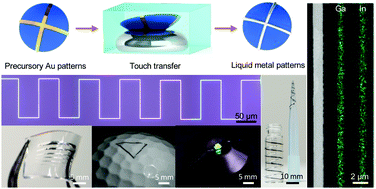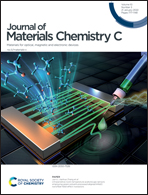Intermetallic wetting enabled high resolution liquid metal patterning for 3D and flexible electronics†
Abstract
Liquid metals, highly conductive and flowable metals, are increasingly becoming versatile choices for soft electronics and wearable devices. High resolution liquid metal patterning strategies accommodative to different substrate materials and geometries are highly desirable. Here, the intermetallic wetting effect between an oxide-free eutectic gallium indium (EGaIn) alloy and a high-surface-energy gold (Au) precursory layer is utilised to fabricate EGaIn patterns with resolutions up to 1.3 μm. The feasibility, reliability, and precision of the method for patterning EGaIn on planar, non-planar, rigid, and flexible substrates of different materials are highlighted. The liquid metal patterns are found to self-adapt to well-defined, curved cross-sectional profiles and their electrical conducting behaviours correlate well with their geometrical dimensions. The EGaIn tracks on flexible polydimethylsiloxane (PDMS) and Ecoflex substrates show reversible resistance changes during repeated strain test, revealing excellent stability under mechanical deformations. A fully functional 3D liquid metal circuit and a resistive motion sensor are designed to demonstrate the potentials of the method for fabricating 3D electronic devices and flexible sensors.

- This article is part of the themed collection: 2022 Journal of Materials Chemistry C Most Popular Articles


 Please wait while we load your content...
Please wait while we load your content...